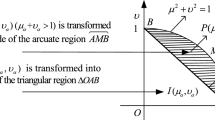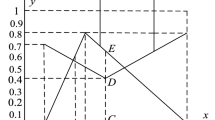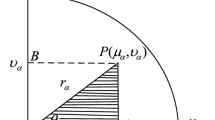Abstract
Pythagorean fuzzy set (PFS) is the most concerned and effective tool to describe fuzzy information in the research of machine learning and decision science, its unique representation ability and theoretical method will be gradually applied to the field of machine learning and even artificial intelligence, which lays a theoretical foundation for further solving complex scientific problems in machine learning. Actually, the PFS is not only a generalization of traditional intuitionistic fuzzy set (IFS), but also a more favorable tool of dealing with uncertain multi-attribute decision-making problem. In particular, it relaxes a certain constraint condition, which greatly increases the range of domain value. Firstly, through counter examples, some defects in the original sorting criteria of Pythagorean fuzzy numbers (PFNs) are pointed out. According to geometric interpretation and theoretical analysis, it is obtained that the reason for the defects is that the definitions of the score function and accuracy function are unreasonable, and the hesitation of PFNs is not considered. Secondly, after abandoning the original score function and accuracy function, concepts of distance index and area of lower triangle are proposed by comparing with the maximum PFN (1, 0). Especially, by considering degrees of hesitation (non-zero) for PFNs, several calculation formulas of curve triangle centroid coordinates corresponding to each PFN are given by using the centroid formula in physics, and then a new centroid distance index is obtained. Finally, two ranking methods for PFNs are established based on centroid distance, including synthetic index ranking and centroid distance ranking. Some examples are given to verify the effectiveness of the proposed methods. The example results show that both ranking methods can overcome the shortcomings in existing approaches, and the centroid distance ranking is better than the synthetic index ranking.










Similar content being viewed by others
References
Atanassov K (1986) Intuitionistic fuzzy sets. Fuzzy Sets Syst 20(1):87–96
Chen SM, Tan JM (1994) Handling multicriteria fuzzy decision-making problems based on vague set theory. Fuzzy Sets Syst 67(2):163–172
Hong DH, Choi CH (2000) Multicriteria fuzzy decision-making problems based on vague set theory. Fuzzy Sets Syst 114(1):103–113
Yager RR (2013) Pythagorean fuzzy subsets. In: Proceeding Joint IFSA World Congress and NAFIPS Annual Meeting, Edmonton, Canada, 57–61
Yager RR, Abbasov AM (2013) Pythagorean membeship grades, complex numbers and decision making. Int J Intell Syst 28:436–452
Yager RR (2014) Pythagorean membership grades in multicriteria decision making. IEEE Trans Fuzzy Syst 22(4):958–965
Zhang XL, Xu ZS (2014) Extension of TOPSIS to multiple criteria decision making with Pythagorean fuzzy sets. Int J Intell Syst 29:1061–1078
Zhang XL (2016) A novel approach based on similarity measure for Pythagorean fuzzy multiple criteria group decision-making. Int J Intell Syst 31:593–611
Peng X, Yang Y (2015) Some results for Pythagorean fuzzy sets. Int J Intell Syst 30(11):1133–1160
Peng X, Yang Y (2016) Fundamental properties of interval-valued Pythagorean fuzzy aggregation operators. Int J Intell Syst 31(5):444–487
Garg H (2016) A novel correlation coefficients between Pythagorean fuzzy sets and its applications to decision-making processes. Int J Intell Syst 31(12):1234–1252
Garg H (2016) A novel accuracy function under interval-valued Pythagorean fuzzy environment for solving multicriteria decision making problem. J Intell Fuzzy Syst 31(1):529–540
Garg H (2017) Confidence levels based Pythagorean fuzzy aggregation operators and its application to decision-making process. Comput Math Organ Theory 23(4):546–571
Wei GW (2018) Similarity measure of Pythagorean fuzzy sets based on the cosine function and their applications. Int J Intell Syst 33(3):634–652
Garg H (2017) A novel improved accuracy function for interval valued Pythagorean fuzzy sets and its applications in decision making process. Int J Intell Syst 31(12):1247–1260
Garg H (2018) A linear programming method based on an improved score function for interval-valued Pythagorean fuzzy numbers and its application to decision-making. Int J Uncert Fuz Knowl Based Syst 26(1):67–80
Garg H (2017) A new improved score function of an interval-valued Pythagorean fuzzy set based TOPSIS method. Int J Uncert Quantif 7(5):463–474
Ren PJ, Xu ZS, Gou XJ (2016) Pythagorean fuzzy TODIM approach to multi-criteria decision making. Appl Soft Comput 42:246–259
Zhang X (2016) Multicriteria Pythagorean fuzzy decision analysis: a hierarchical QUALIFLEX approach with the closeness based ranking. Inform Sci 330:104–124
Garg H (2018) Linguistic Pythagorean fuzzy sets and its applications in multiattribute decision-making process. Int J Intell Syst 33(6):1234–1263
Wei GW, Lu M (2018) Pythagorean fuzzy Maclaurin symmetric mean operators in multiple attribute decision making. Int J Intell Syst 33(5):1043–1070
Peng X, Selvachandran G (2017) Pythagorean fuzzy set: state of the art and future directions. Artif Intell Rev 1:1–55
Rahman K, Abdullah S, Ahmad R (2017) Pythagorean fuzzy Einstein geometric operators and their application to multiple attribute decision making. J Intell Fuzzy Syst 33:635–647
Rahman K, Khan MSA, Abdullah S, Hussain F (2017) Some properties of Pythagorean fuzzy hybrid averaging aggregation operator. J Appl Environ Biol Sci 7:122–133
Rahman K, Khan MSA, Ullah M, Fahmi A (2017) Multiple attribute group decision making for plant location selection with Pythagorean fuzzy weighted geometric aggregation operator. Nucleus 54:66–74
Ullah K, Mahmood Ali Z et al (2020) On some distance measures of complex Pythagorean fuzzy sets and their applications in pattern recognition. Complex Intell Syst 6(1):15–27
Firozja MA, Agheli B, Jamkhaneh EB (2020) A new similarity measure for Pythagorean fuzzy sets. Complex Intell Syst 6(1):67–74
Khan MSA, Abdullah S, Ali MY et al (2017) Pythagorean hesitant fuzzy sets and their application to group decision making with incomplete weight information. J Intell Fuzzy Syst 33:3971–3985
Khan MSA, Abdullah S, Ali MY et al (2018) Extension of TOPSIS method based on Choquet integral under interval-valued Pythagorean fuzzy environment. J Intell Fuzzy Syst 34:267–282
Rani P, Mishra AR, Rezaei G et al (2020) Extended Pythagorean fuzzy TOPSIS method based on similarity measure for sustainable recycling partner selection. Int J Fuzzy Syst 22(2):735–747
Wang GJ, Duan Y (2018) TOPSIS approach for multi-attribute decision making problems based on n-intuitionistic polygonal fuzzy sets description. Comput Ind Eng 124(10):573–581
Wang GJ, Tao YJ, Li YH (2020) TOPSIS evaluation system of logistics transportation based on an ordered representation of the polygonal fuzzy set. Int J Fuzzy Syst 22(5):1565–1581
Yager RR (2019) Extending set measures to Pythagorean fuzzy sets. Int J Fuzzy Syst 21(2):343–354
Shakeel M, Abdullah S, Shahzad M et al (2019) Geometric aggregation operators with interval-valued Pythagorean trapezoidal fuzzy numbers based on Einstein operations and their application in group decision making. Int J Mach Learn Cybern 10(10):2867–2886
Peng XD, Zhang XL, Luo Z (2020) Pythagorean fuzzy MCDM method based on CoCoSo and CRITIC with score function for 5G industry evaluation. Artif Intell Rev 53(5):3813–3847
Ullah K, Mahmood T, Ali Z et al (2020) On some distance measures of complex Pythagorean fuzzy sets and their applications in pattern recognition. Complex Intell Syst 6(1):15–27
Li XP, Li YH, Tao YJ (2021) Representation and aggregation of multi-source information of modern smart cities based on the intuitionistic polygonal fuzzy set. Int J Fuzzy Syst 23(4):967–983
Li XP, Tao YJ, Li YH (2020) Decision making method for evaluating logistics companies based on the ordered representation of the polygonal fuzziness. J Intell Fuzzy Syst 39(3):3151–3166
Li XP, Li D (2016) The structure and realization of a polygonal fuzzy neural network. Int J Mach Learn Cybern 7(3):375–389
Li X, Huang XA (2020) Novel three-way investment decisions based on decision-theoretic rough sets with hesitant fuzzy Information. Int J Fuzzy Syst 22(8):2708–2719
Li Z, Xie N, Huang D et al (2020) A three-way decision method in a hybrid decision information system and its application in medical diagnosis. Artif Intell Rev 53(7):4707–4736
Zhang M, Zhang QH, Gao M (2021) A sequential three-way decision model based on hesitant fuzzy sets. J Intell Fuzzy Syst 40(5):9073–9084
Author information
Authors and Affiliations
Corresponding author
Additional information
Publisher's Note
Springer Nature remains neutral with regard to jurisdictional claims in published maps and institutional affiliations.
This Work Has Been Supported By National Natural Science Foundation of China (Grant No. 61463019), Natural Science Foundation of Hunan Province (Grant No. 2019JJ40062).
Rights and permissions
About this article
Cite this article
Sun, G., Li, X. & Chen, D. Ranking defects and solving countermeasures for Pythagorean fuzzy sets with hesitant degree. Int. J. Mach. Learn. & Cyber. 13, 1265–1281 (2022). https://doi.org/10.1007/s13042-021-01446-x
Received:
Accepted:
Published:
Issue Date:
DOI: https://doi.org/10.1007/s13042-021-01446-x




